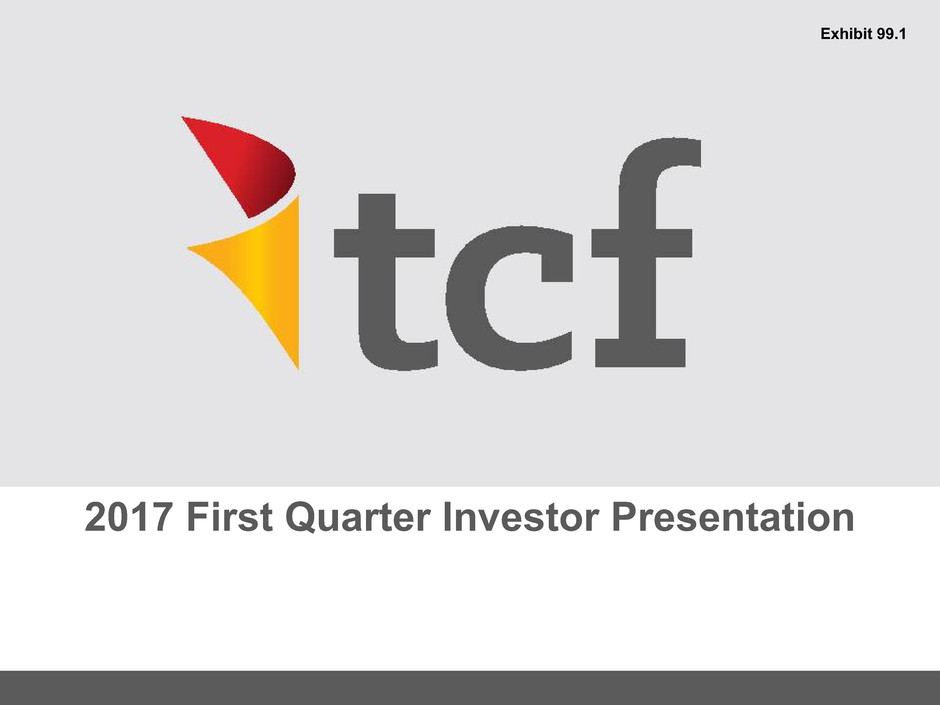
2017 First Quarter Investor Presentation Exhibit 99.1
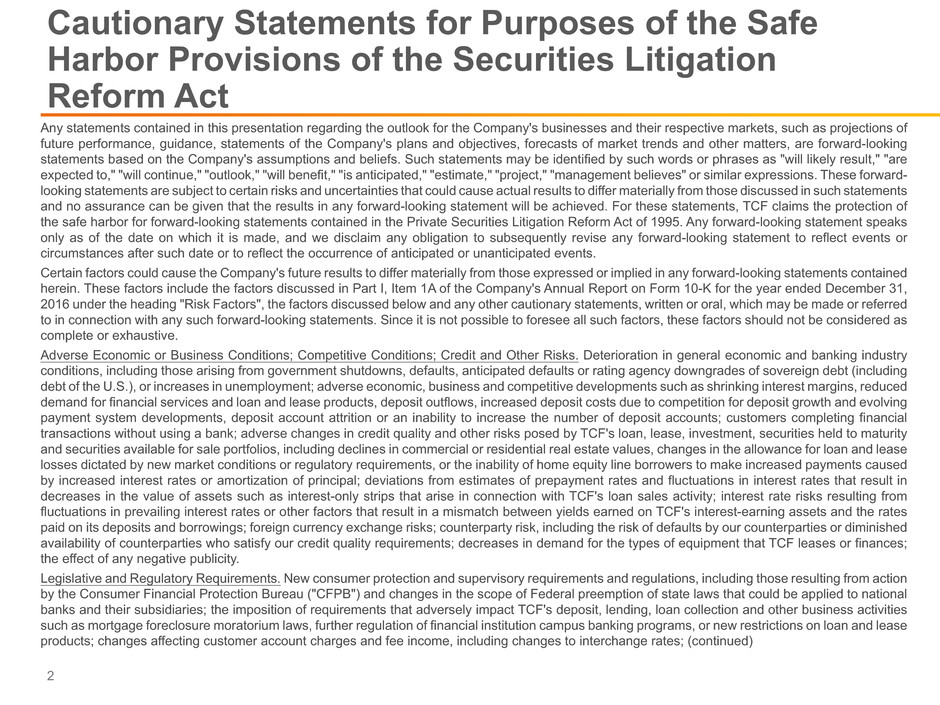
Cautionary Statements for Purposes of the Safe Harbor Provisions of the Securities Litigation Reform Act Any statements contained in this presentation regarding the outlook for the Company's businesses and their respective markets, such as projections of future performance, guidance, statements of the Company's plans and objectives, forecasts of market trends and other matters, are forward-looking statements based on the Company's assumptions and beliefs. Such statements may be identified by such words or phrases as "will likely result," "are expected to," "will continue," "outlook," "will benefit," "is anticipated," "estimate," "project," "management believes" or similar expressions. These forward- looking statements are subject to certain risks and uncertainties that could cause actual results to differ materially from those discussed in such statements and no assurance can be given that the results in any forward-looking statement will be achieved. For these statements, TCF claims the protection of the safe harbor for forward-looking statements contained in the Private Securities Litigation Reform Act of 1995. Any forward-looking statement speaks only as of the date on which it is made, and we disclaim any obligation to subsequently revise any forward-looking statement to reflect events or circumstances after such date or to reflect the occurrence of anticipated or unanticipated events. Certain factors could cause the Company's future results to differ materially from those expressed or implied in any forward-looking statements contained herein. These factors include the factors discussed in Part I, Item 1A of the Company's Annual Report on Form 10-K for the year ended December 31, 2016 under the heading "Risk Factors", the factors discussed below and any other cautionary statements, written or oral, which may be made or referred to in connection with any such forward-looking statements. Since it is not possible to foresee all such factors, these factors should not be considered as complete or exhaustive. Adverse Economic or Business Conditions; Competitive Conditions; Credit and Other Risks. Deterioration in general economic and banking industry conditions, including those arising from government shutdowns, defaults, anticipated defaults or rating agency downgrades of sovereign debt (including debt of the U.S.), or increases in unemployment; adverse economic, business and competitive developments such as shrinking interest margins, reduced demand for financial services and loan and lease products, deposit outflows, increased deposit costs due to competition for deposit growth and evolving payment system developments, deposit account attrition or an inability to increase the number of deposit accounts; customers completing financial transactions without using a bank; adverse changes in credit quality and other risks posed by TCF's loan, lease, investment, securities held to maturity and securities available for sale portfolios, including declines in commercial or residential real estate values, changes in the allowance for loan and lease losses dictated by new market conditions or regulatory requirements, or the inability of home equity line borrowers to make increased payments caused by increased interest rates or amortization of principal; deviations from estimates of prepayment rates and fluctuations in interest rates that result in decreases in the value of assets such as interest-only strips that arise in connection with TCF's loan sales activity; interest rate risks resulting from fluctuations in prevailing interest rates or other factors that result in a mismatch between yields earned on TCF's interest-earning assets and the rates paid on its deposits and borrowings; foreign currency exchange risks; counterparty risk, including the risk of defaults by our counterparties or diminished availability of counterparties who satisfy our credit quality requirements; decreases in demand for the types of equipment that TCF leases or finances; the effect of any negative publicity. Legislative and Regulatory Requirements. New consumer protection and supervisory requirements and regulations, including those resulting from action by the Consumer Financial Protection Bureau ("CFPB") and changes in the scope of Federal preemption of state laws that could be applied to national banks and their subsidiaries; the imposition of requirements that adversely impact TCF's deposit, lending, loan collection and other business activities such as mortgage foreclosure moratorium laws, further regulation of financial institution campus banking programs, or new restrictions on loan and lease products; changes affecting customer account charges and fee income, including changes to interchange rates; (continued) 2
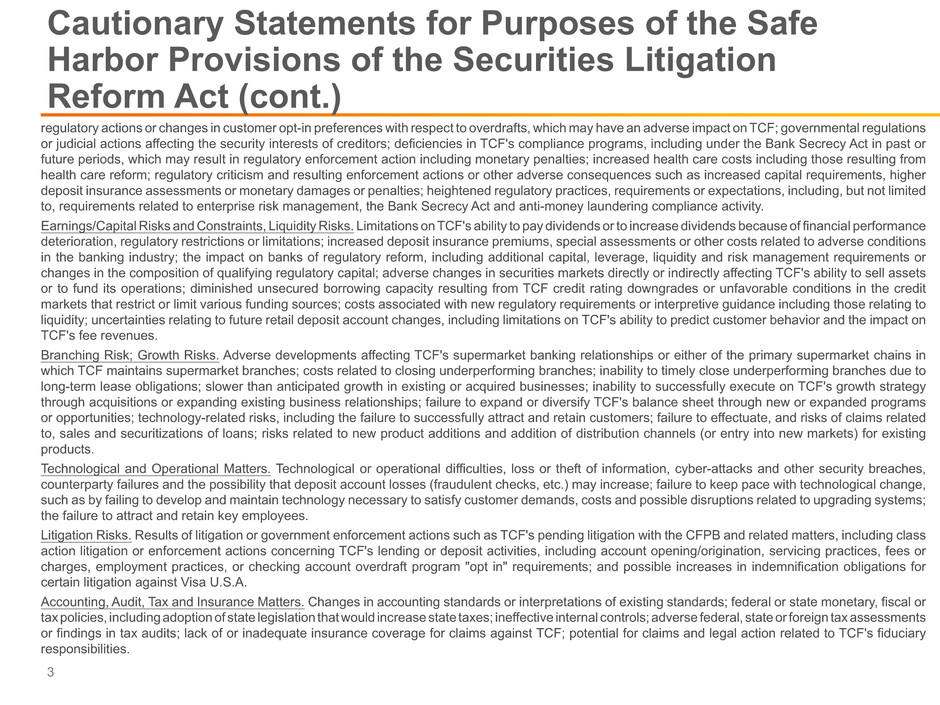
Cautionary Statements for Purposes of the Safe Harbor Provisions of the Securities Litigation Reform Act (cont.) regulatory actions or changes in customer opt-in preferences with respect to overdrafts, which may have an adverse impact on TCF; governmental regulations or judicial actions affecting the security interests of creditors; deficiencies in TCF's compliance programs, including under the Bank Secrecy Act in past or future periods, which may result in regulatory enforcement action including monetary penalties; increased health care costs including those resulting from health care reform; regulatory criticism and resulting enforcement actions or other adverse consequences such as increased capital requirements, higher deposit insurance assessments or monetary damages or penalties; heightened regulatory practices, requirements or expectations, including, but not limited to, requirements related to enterprise risk management, the Bank Secrecy Act and anti-money laundering compliance activity. Earnings/Capital Risks and Constraints, Liquidity Risks. Limitations on TCF's ability to pay dividends or to increase dividends because of financial performance deterioration, regulatory restrictions or limitations; increased deposit insurance premiums, special assessments or other costs related to adverse conditions in the banking industry; the impact on banks of regulatory reform, including additional capital, leverage, liquidity and risk management requirements or changes in the composition of qualifying regulatory capital; adverse changes in securities markets directly or indirectly affecting TCF's ability to sell assets or to fund its operations; diminished unsecured borrowing capacity resulting from TCF credit rating downgrades or unfavorable conditions in the credit markets that restrict or limit various funding sources; costs associated with new regulatory requirements or interpretive guidance including those relating to liquidity; uncertainties relating to future retail deposit account changes, including limitations on TCF's ability to predict customer behavior and the impact on TCF's fee revenues. Branching Risk; Growth Risks. Adverse developments affecting TCF's supermarket banking relationships or either of the primary supermarket chains in which TCF maintains supermarket branches; costs related to closing underperforming branches; inability to timely close underperforming branches due to long-term lease obligations; slower than anticipated growth in existing or acquired businesses; inability to successfully execute on TCF's growth strategy through acquisitions or expanding existing business relationships; failure to expand or diversify TCF's balance sheet through new or expanded programs or opportunities; technology-related risks, including the failure to successfully attract and retain customers; failure to effectuate, and risks of claims related to, sales and securitizations of loans; risks related to new product additions and addition of distribution channels (or entry into new markets) for existing products. Technological and Operational Matters. Technological or operational difficulties, loss or theft of information, cyber-attacks and other security breaches, counterparty failures and the possibility that deposit account losses (fraudulent checks, etc.) may increase; failure to keep pace with technological change, such as by failing to develop and maintain technology necessary to satisfy customer demands, costs and possible disruptions related to upgrading systems; the failure to attract and retain key employees. Litigation Risks. Results of litigation or government enforcement actions such as TCF's pending litigation with the CFPB and related matters, including class action litigation or enforcement actions concerning TCF's lending or deposit activities, including account opening/origination, servicing practices, fees or charges, employment practices, or checking account overdraft program "opt in" requirements; and possible increases in indemnification obligations for certain litigation against Visa U.S.A. Accounting, Audit, Tax and Insurance Matters. Changes in accounting standards or interpretations of existing standards; federal or state monetary, fiscal or tax policies, including adoption of state legislation that would increase state taxes; ineffective internal controls; adverse federal, state or foreign tax assessments or findings in tax audits; lack of or inadequate insurance coverage for claims against TCF; potential for claims and legal action related to TCF's fiduciary responsibilities. 3
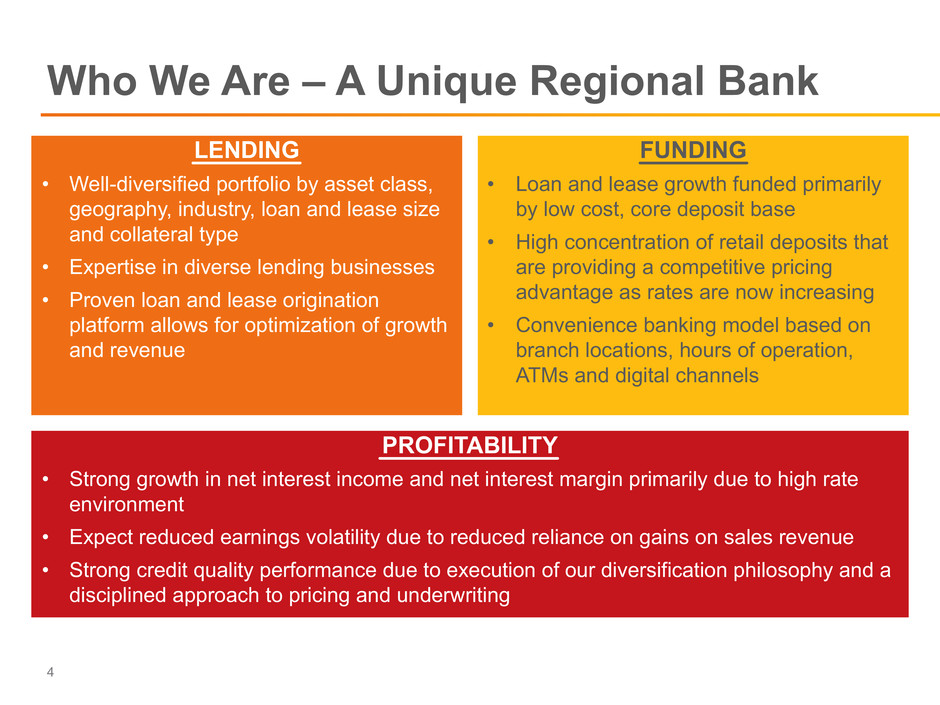
Who We Are – A Unique Regional Bank 4 LENDING • Well-diversified portfolio by asset class, geography, industry, loan and lease size and collateral type • Expertise in diverse lending businesses • Proven loan and lease origination platform allows for optimization of growth and revenue FUNDING • Loan and lease growth funded primarily by low cost, core deposit base • High concentration of retail deposits that are providing a competitive pricing advantage as rates are now increasing • Convenience banking model based on branch locations, hours of operation, ATMs and digital channels PROFITABILITY • Strong growth in net interest income and net interest margin primarily due to high rate environment • Expect reduced earnings volatility due to reduced reliance on gains on sales revenue • Strong credit quality performance due to execution of our diversification philosophy and a disciplined approach to pricing and underwriting
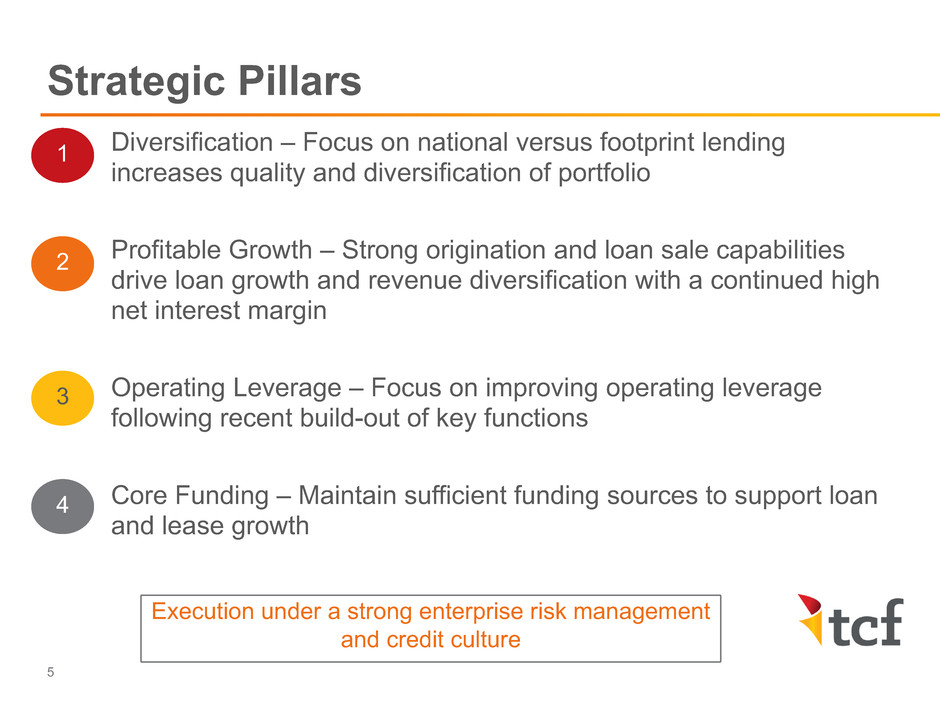
Diversification – Focus on national versus footprint lending increases quality and diversification of portfolio Profitable Growth – Strong origination and loan sale capabilities drive loan growth and revenue diversification with a continued high net interest margin Operating Leverage – Focus on improving operating leverage following recent build-out of key functions Core Funding – Maintain sufficient funding sources to support loan and lease growth Strategic Pillars 5 1 2 3 4 Execution under a strong enterprise risk management and credit culture
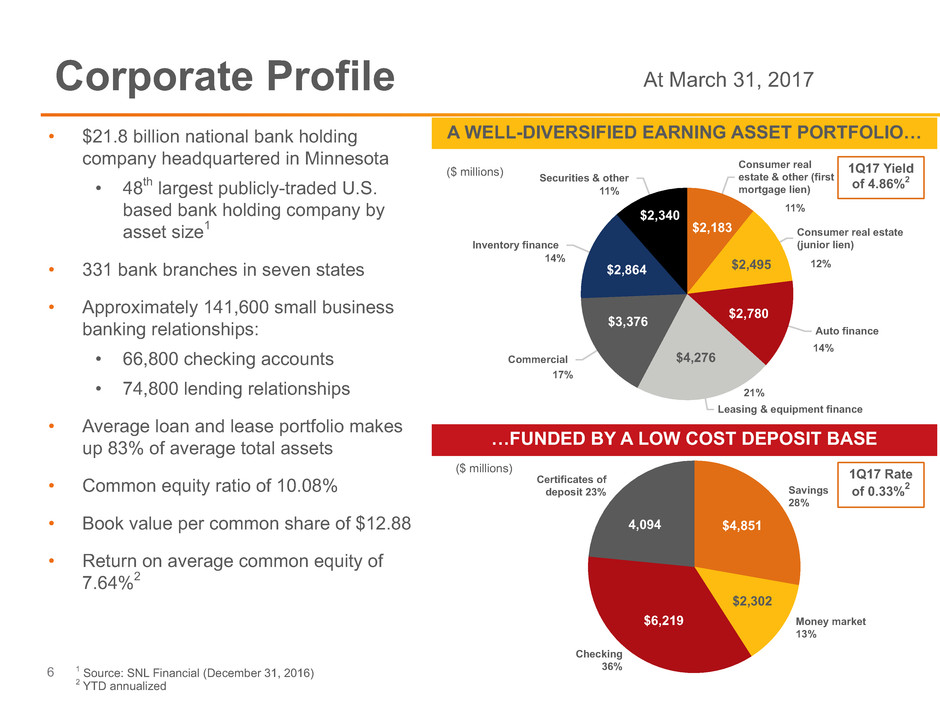
Consumer real estate & other (first mortgage lien) Consumer real estate (junior lien) Auto finance Leasing & equipment finance Commercial Inventory finance Securities & other Corporate Profile Savings 28% Money market 13% Checking 36% Certificates of deposit 23% • $21.8 billion national bank holding company headquartered in Minnesota • 48th largest publicly-traded U.S. based bank holding company by asset size1 • 331 bank branches in seven states • Approximately 141,600 small business banking relationships: • 66,800 checking accounts • 74,800 lending relationships • Average loan and lease portfolio makes up 83% of average total assets • Common equity ratio of 10.08% • Book value per common share of $12.88 • Return on average common equity of 7.64%2 6 ($ millions) 1 Source: SNL Financial (December 31, 2016) 2 YTD annualized ($ millions) At March 31, 2017 1Q17 Yield of 4.86%2 1Q17 Rate of 0.33%2 $4,851 $6,219 $2,302 4,094 $2,183 $3,376 $4,276 $2,780 $2,495 $2,864 $2,340 A WELL-DIVERSIFIED EARNING ASSET PORTFOLIO… …FUNDED BY A LOW COST DEPOSIT BASE 11% 11% 12% 14% 21% 17% 14%
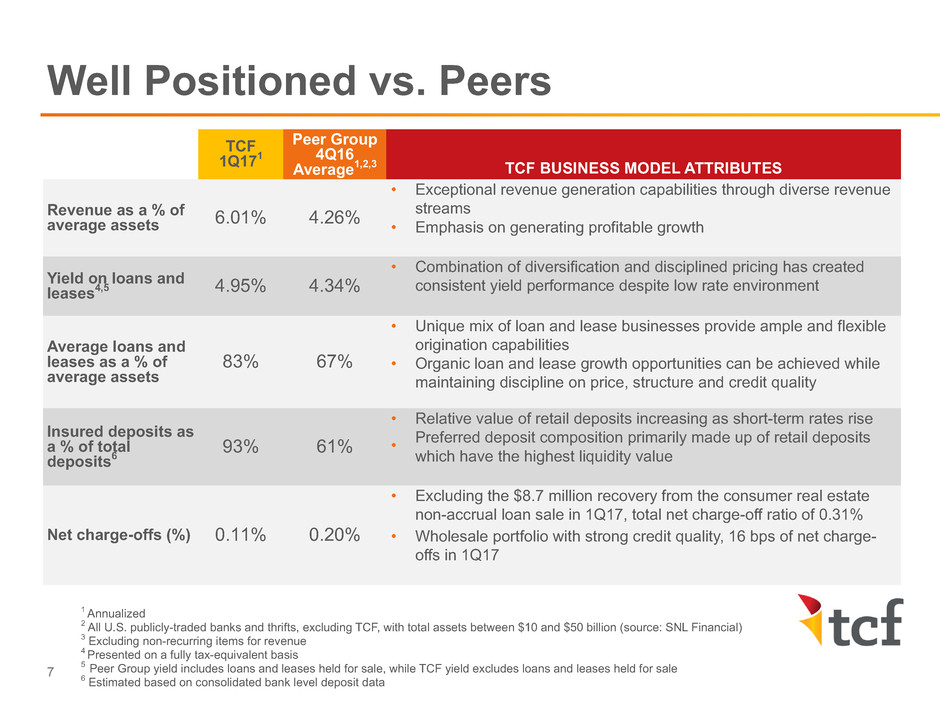
Well Positioned vs. Peers 7 1 Annualized 2 All U.S. publicly-traded banks and thrifts, excluding TCF, with total assets between $10 and $50 billion (source: SNL Financial) 3 Excluding non-recurring items for revenue 4 Presented on a fully tax-equivalent basis 5 Peer Group yield includes loans and leases held for sale, while TCF yield excludes loans and leases held for sale 6 Estimated based on consolidated bank level deposit data 5 TCF 1Q171 Peer Group 4Q16 Average1,2,3 TCF BUSINESS MODEL ATTRIBUTES Revenue as a % of average assets 6.01% 4.26% • • Exceptional revenue generation capabilities through diverse revenue streams Emphasis on generating profitable growth Yield on loans and leases4,5 4.95% 4.34% • Combination of diversification and disciplined pricing has created consistent yield performance despite low rate environment Average loans and leases as a % of average assets 83% 67% • • Unique mix of loan and lease businesses provide ample and flexible origination capabilities Organic loan and lease growth opportunities can be achieved while maintaining discipline on price, structure and credit quality Insured deposits as a % of total deposits6 93% 61% • • Relative value of retail deposits increasing as short-term rates rise Preferred deposit composition primarily made up of retail deposits which have the highest liquidity value Net charge-offs (%) 0.11% 0.20% • Excluding the $8.7 million recovery from the consumer real estate non-accrual loan sale in 1Q17, total net charge-off ratio of 0.31% • Wholesale portfolio with strong credit quality, 16 bps of net charge- offs in 1Q17
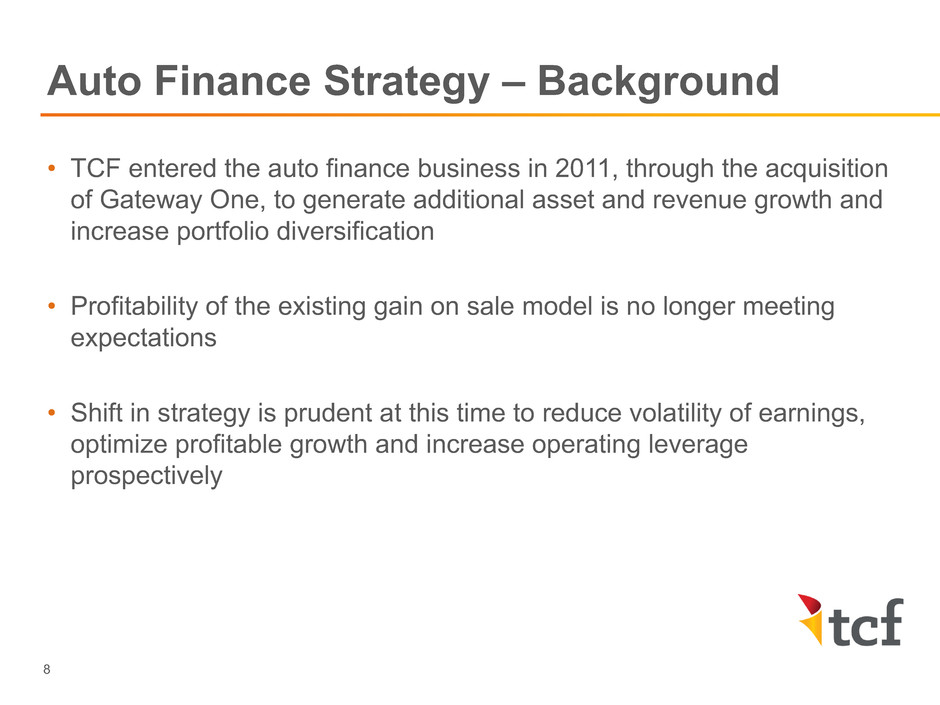
Auto Finance Strategy – Background • TCF entered the auto finance business in 2011, through the acquisition of Gateway One, to generate additional asset and revenue growth and increase portfolio diversification • Profitability of the existing gain on sale model is no longer meeting expectations • Shift in strategy is prudent at this time to reduce volatility of earnings, optimize profitable growth and increase operating leverage prospectively 8
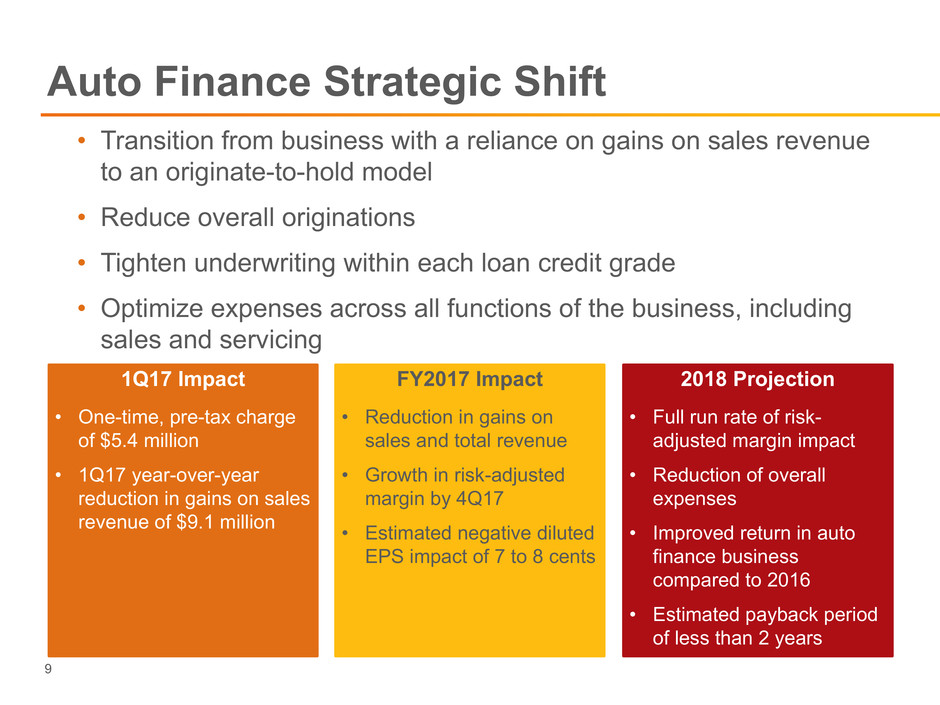
Auto Finance Strategic Shift • Transition from business with a reliance on gains on sales revenue to an originate-to-hold model • Reduce overall originations • Tighten underwriting within each loan credit grade • Optimize expenses across all functions of the business, including sales and servicing 1Q17 Impact • One-time, pre-tax charge of $5.4 million • 1Q17 year-over-year reduction in gains on sales revenue of $9.1 million FY2017 Impact • Reduction in gains on sales and total revenue • Growth in risk-adjusted margin by 4Q17 • Estimated negative diluted EPS impact of 7 to 8 cents 2018 Projection • Full run rate of risk- adjusted margin impact • Reduction of overall expenses • Improved return in auto finance business compared to 2016 • Estimated payback period of less than 2 years 9
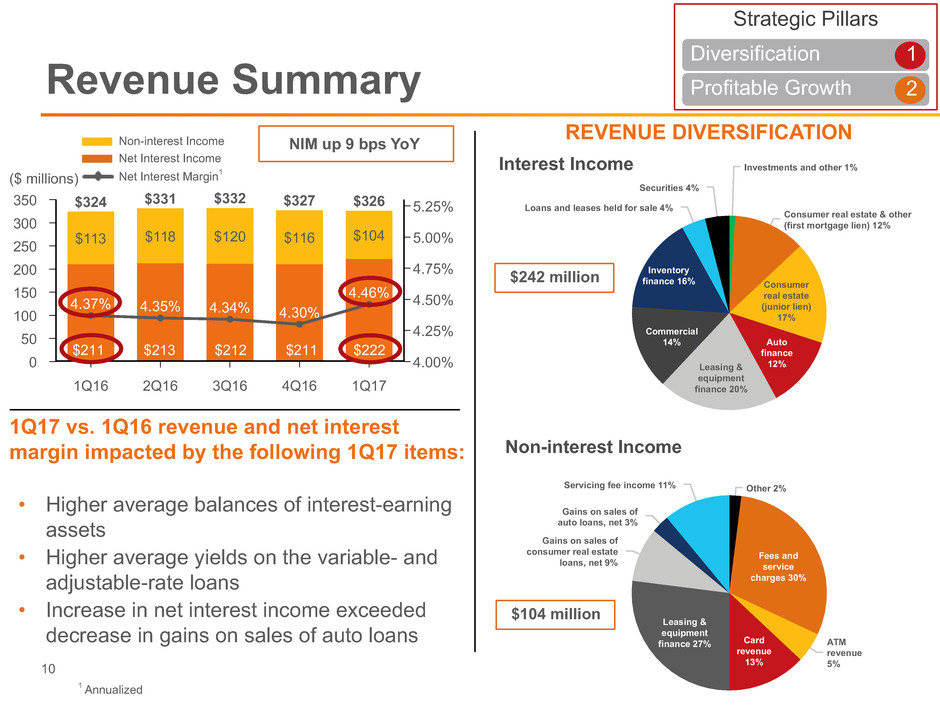
Other 2% Fees and service charges 30% ATM revenue 5% Card revenue 13% Leasing & equipment finance 27% Gains on sales of consumer real estate loans, net 9% Gains on sales of auto loans, net 3% Servicing fee income 11% Investments and other 1% Consumer real estate & other (first mortgage lien) 12% Consumer real estate (junior lien) 17% Auto finance 12%Leasing & equipment finance 20% Commercial 14% Inventory finance 16% Loans and leases held for sale 4% Securities 4% NIM up 9 bps YoY 350 300 250 200 150 100 50 0 5.25% 5.00% 4.75% 4.50% 4.25% 4.00% 1Q16 2Q16 3Q16 4Q16 1Q17 $113 $324 $118 $331 $120 $332 $116 $327 $104 $326 4.37% 4.35% 4.34% 4.30% 4.46% Net Interest Margin1 1Q17 vs. 1Q16 revenue and net interest margin impacted by the following 1Q17 items: • Higher average balances of interest-earning assets • Higher average yields on the variable- and adjustable-rate loans • Increase in net interest income exceeded decrease in gains on sales of auto loans 1 Annualized Revenue Summary REVENUE DIVERSIFICATION $242 million Non-interest Income Interest Income ($ millions) $211 $213 $212 $211 $222 Non-interest Income Net Interest Income $104 million Strategic Pillars Diversification 1 Profitable Growth 2 10

• Compensation and employee benefits expense increased on a linked quarter basis primarily due to seasonality, but remained flat year-over-year • Other non-interest expense increased primarily due to higher severance expense in the auto finance business and strategic investments in technology capabilities 1 Includes Occupancy & Equipment, Other Non-interest Expense, Foreclosed Real Estate & Repossessed Assets and Other Credit Costs Non-interest Expense 250 200 150 100 50 0 1Q16 2Q16 3Q16 4Q16 1Q17 $124 $118 $117 $115 $124 $94 $99 $102 $99 $109 $10 $228 $10 $227 $10 $229 $11 $225 $11 $244 Compensation & Employee Benefits Foreclosed Real Estate and Other Credit Cost Compensation & Employee Benefits 350 300 250 200 150 100 50 0 $ (M ill io ns ) 6/14 9/14 12/14 3/15 6/15 ($ millions) Operating Lease Depreciation Other 1 Compensation & Employee Benefits Efficiency Ratio: 70.42% 68.69% 69.00% 68.89% 74.93% Strategic Pillars Profitable Growth 2 Operating Leverage 3 11
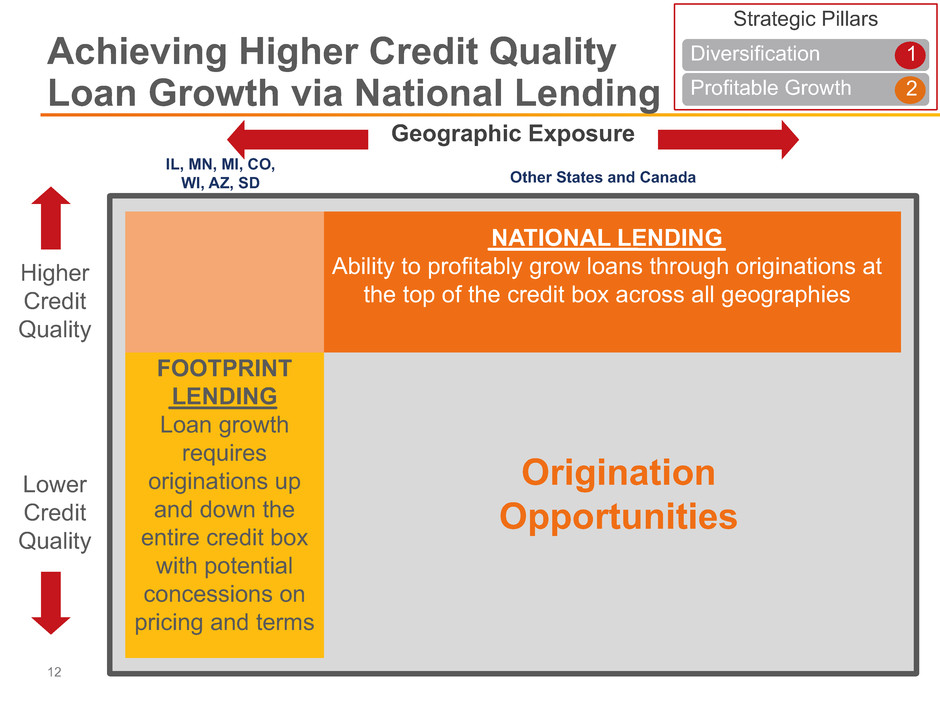
Achieving Higher Credit Quality Loan Growth via National Lending 12 FOOTPRINT LENDING Loan growth requires originations up and down the entire credit box with potential concessions on pricing and terms NATIONAL LENDING Ability to profitably grow loans through originations at the top of the credit box across all geographies Higher Credit Quality Lower Credit Quality Geographic Exposure Origination Opportunities IL, MN, MI, CO, WI, AZ, SD Other States and Canada Strategic Pillars Diversification 1 Profitable Growth 2
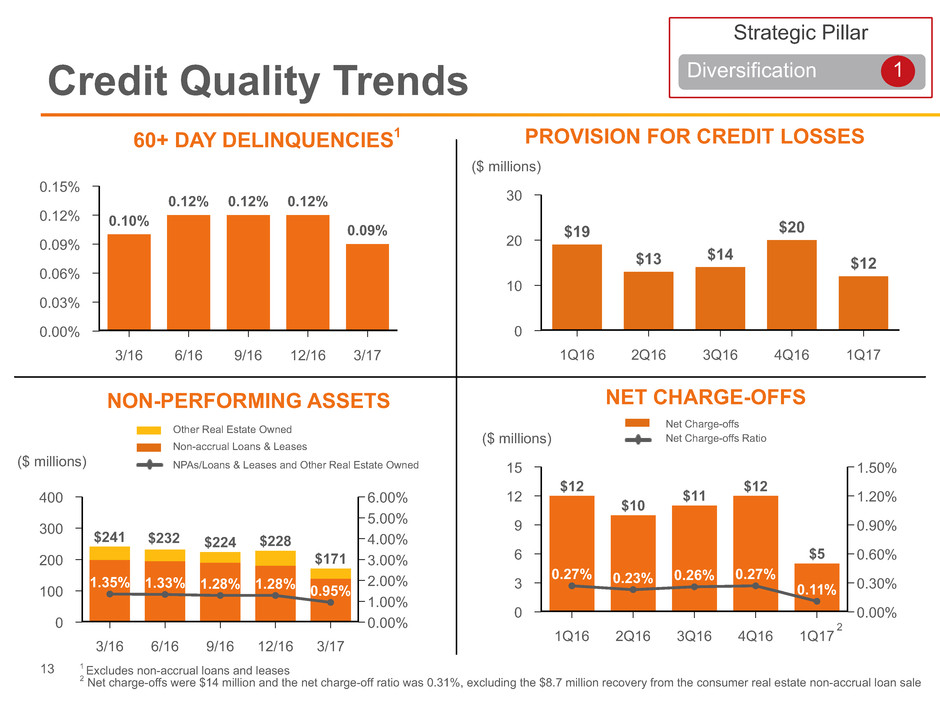
PROVISION FOR CREDIT LOSSES 30 20 10 0 1Q16 2Q16 3Q16 4Q16 1Q17 $19 $13 $14 $20 $12 1 Excludes non-accrual loans and leases 2 Net charge-offs were $14 million and the net charge-off ratio was 0.31%, excluding the $8.7 million recovery from the consumer real estate non-accrual loan sale ($ millions) Credit Quality Trends 0.15% 0.12% 0.09% 0.06% 0.03% 0.00% 3/16 6/16 9/16 12/16 3/17 0.10% 0.12% 0.12% 0.12% 0.09% 400 300 200 100 0 6.00% 5.00% 4.00% 3.00% 2.00% 1.00% 0.00% 3/16 6/16 9/16 12/16 3/17 $241 $224 $228 $171 1.35% 1.33% 1.28% 1.28% 0.95% ($ millions) 60+ DAY DELINQUENCIES1 NET CHARGE-OFFSNON-PERFORMING ASSETS Other Real Estate Owned Non-accrual Loans & Leases NPAs/Loans & Leases and Other Real Estate Owned Strategic Pillar Diversification 1 $232 15 12 9 6 3 0 1.50% 1.20% 0.90% 0.60% 0.30% 0.00% 1Q16 2Q16 3Q16 4Q16 1Q17 $12 $10 $11 $12 $5 0.27% 0.23% 0.26% 0.27% 0.11% 2 Net Charge-offs Net Charge-offs Ratio 13 ($ millions)
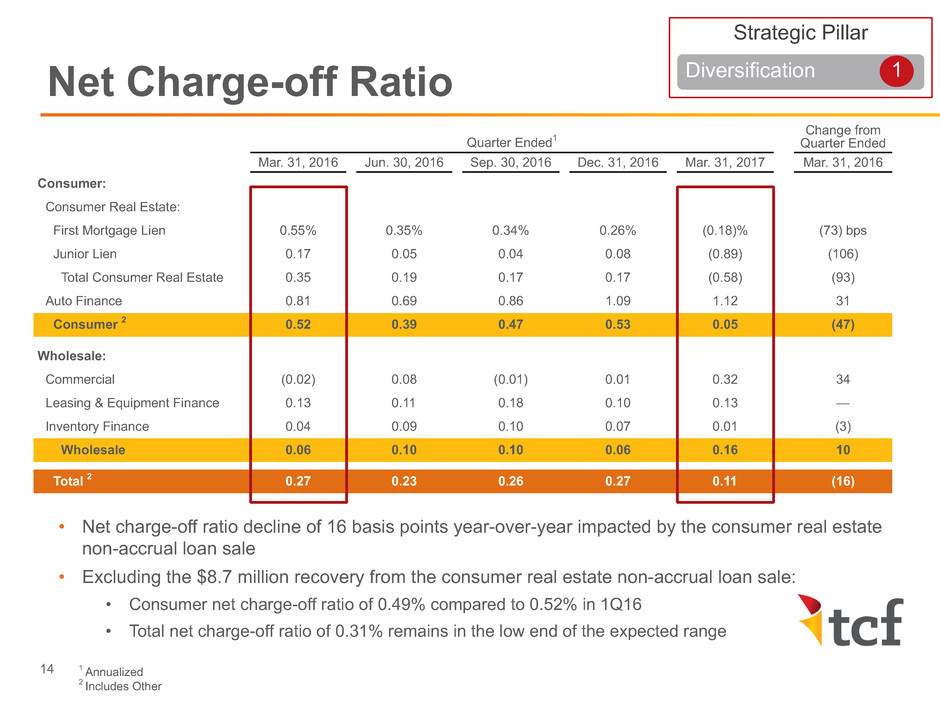
1 Annualized 2 Includes Other Net Charge-off Ratio Quarter Ended1 Change from Quarter Ended Mar. 31, 2016 Jun. 30, 2016 Sep. 30, 2016 Dec. 31, 2016 Mar. 31, 2017 Mar. 31, 2016 Consumer: Consumer Real Estate: First Mortgage Lien 0.55% 0.35% 0.34% 0.26% (0.18)% (73) bps Junior Lien 0.17 0.05 0.04 0.08 (0.89) (106) Total Consumer Real Estate 0.35 0.19 0.17 0.17 (0.58) (93) Auto Finance 0.81 0.69 0.86 1.09 1.12 31 Consumer 2 0.52 0.39 0.47 0.53 0.05 (47) Wholesale: Commercial (0.02) 0.08 (0.01) 0.01 0.32 34 Leasing & Equipment Finance 0.13 0.11 0.18 0.10 0.13 — Inventory Finance 0.04 0.09 0.10 0.07 0.01 (3) Wholesale 0.06 0.10 0.10 0.06 0.16 10 Total 2 0.27 0.23 0.26 0.27 0.11 (16) Strategic Pillar Diversification 1 • Net charge-off ratio decline of 16 basis points year-over-year impacted by the consumer real estate non-accrual loan sale • Excluding the $8.7 million recovery from the consumer real estate non-accrual loan sale: • Consumer net charge-off ratio of 0.49% compared to 0.52% in 1Q16 • Total net charge-off ratio of 0.31% remains in the low end of the expected range 14

43% 20% 37% 1Q17 AVERAGE EARNING ASSETS 1Q17 AVERAGE DEPOSITS $17.1 billion 2016 2017 4.50% 4.45% 4.40% 4.35% 4.30% 4.25% 1Q 2Q 3Q 4Q 4.37% 4.35% 4.34% 4.30% 4.46% 40% 42% 18% Positive Impact of Rising Interest Rates 15 • 82% of assets are variable/ adjustable rate or short/ medium duration fixed rate • 63% of deposits are low or no interest cost with an average cost of one basis point for 1Q17 • Net interest margin up 9 basis points year-over-year • Seasonality of inventory finance balances results in similar seasonality of net interest margin Variable/Adjustable Rate1 Fixed Rate - Short/Medium Duration2 Fixed Rate - Long Duration3 Low Interest Cost No Interest Cost Other Strategic Pillars Diversification 1 Profitable Growth 2 $20.4 billion 1 Includes Inventory Finance, Commercial, Consumer Real Estate and Investments 2 Includes Commercial, Leasing and Auto Finance 3 Includes Securities and Consumer Real Estate NET INTEREST MARGIN FY16: 4.34% 1Q17: 4.46%
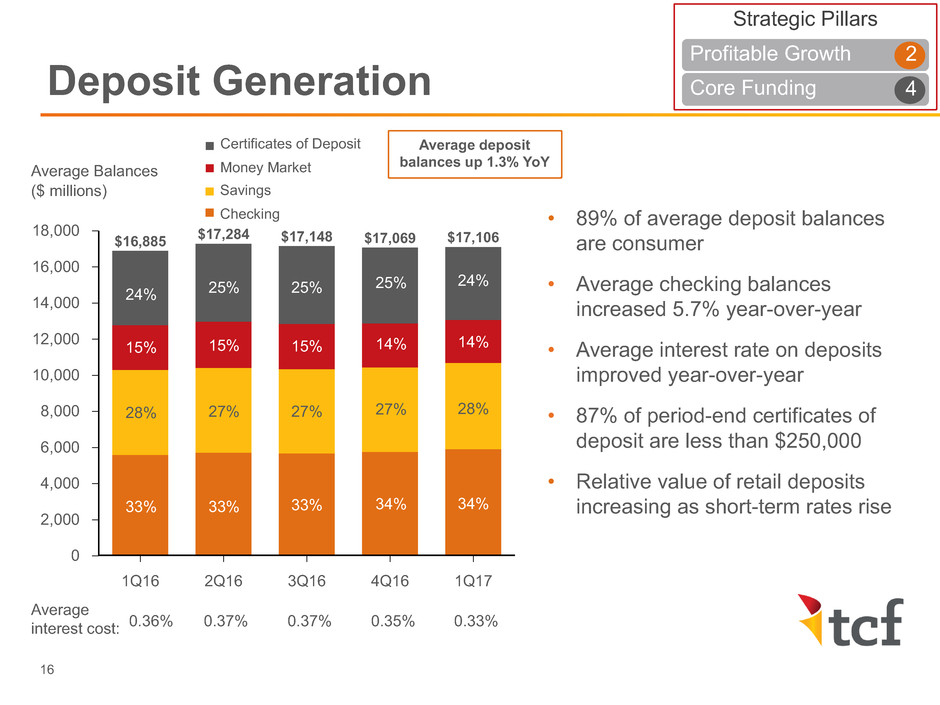
18,000 16,000 14,000 12,000 10,000 8,000 6,000 4,000 2,000 0 1Q16 2Q16 3Q16 4Q16 1Q17 $16,885 $17,284 $17,148 $17,069 $17,106 0.36% 0.37% 0.37% 0.35% 0.33% Average interest cost: Deposit Generation Average Balances ($ millions) Certificates of Deposit Money Market Savings Checking Strategic Pillars Profitable Growth 2 Core Funding 4 24% 15% 28% 33% 25% 15% 27% 33% 25% 15% 27% 33% 25% 14% 27% 34% 24% 14% 28% 34% 16 Average deposit balances up 1.3% YoY • 89% of average deposit balances are consumer • Average checking balances increased 5.7% year-over-year • Average interest rate on deposits improved year-over-year • 87% of period-end certificates of deposit are less than $250,000 • Relative value of retail deposits increasing as short-term rates rise
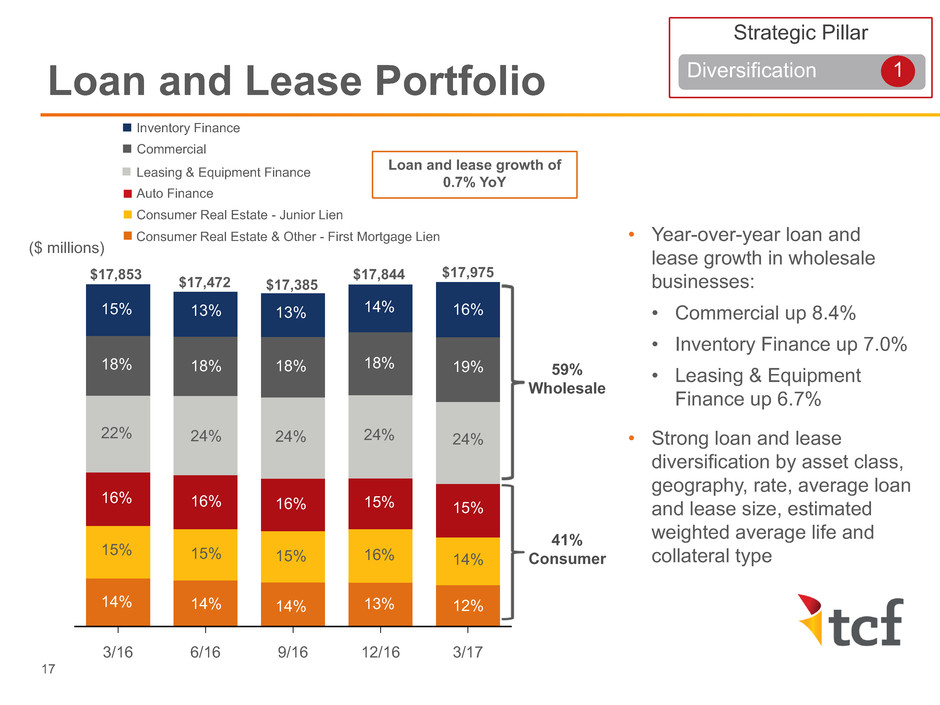
3/16 6/16 9/16 12/16 3/17 $17,854 $17,472 $17,384 $17,844 $17,975 13% 18% 24% 16% 15% 14% 13% 18% 24% 16% 15% 14% 14% 18% 24% 15% 16% 13% • Year-over-year loan and lease growth in wholesale businesses: • Commercial up 8.4% • Inventory Finance up 7.0% • Leasing & Equipment Finance up 6.7% • Strong loan and lease diversification by asset class, geography, rate, average loan and lease size, estimated weighted average life and collateral type 59% Wholesale 41% Consumer Loan and Lease Portfolio ($ millions) 15% 18% 22% 16% 15% 14% Inventory Finance Leasing & Equipment Finance Commercial Auto Finance Consumer Real Estate - Junior Lien Consumer Real Estate & Other - First Mortgage Lien $17,47 16% 19% 24% 15% 14% 12% Strategic Pillar Diversification 1 Loan and lease growth of 0.7% YoY $17,84 $17,853 $17,385 17
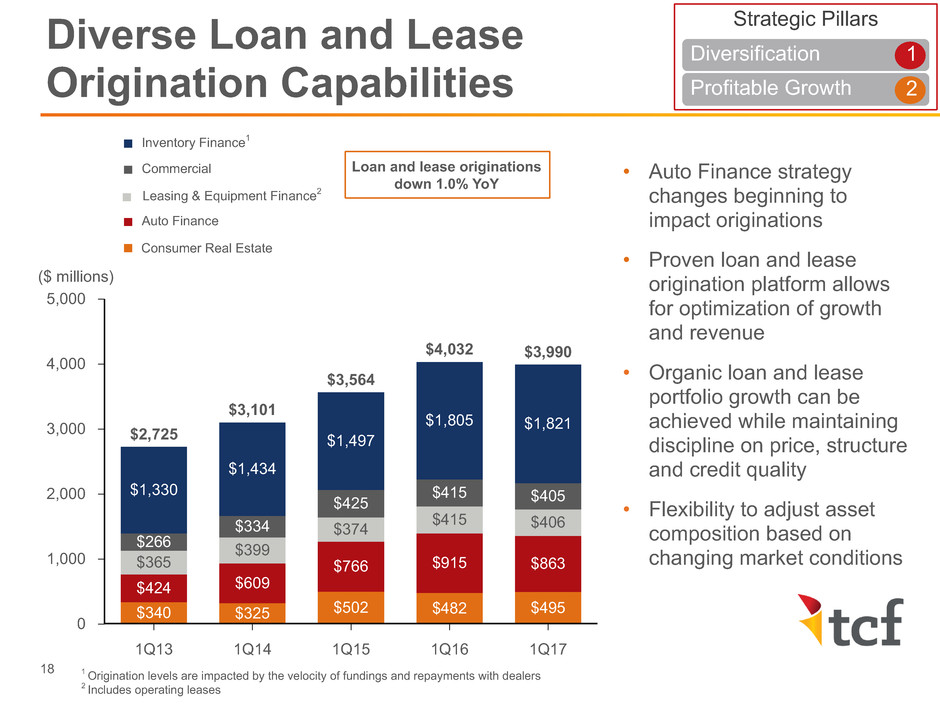
5,000 4,000 3,000 2,000 1,000 0 1Q13 1Q14 1Q15 1Q16 1Q17 $340 $325 $502 $482 $495 $424 $609 $766 $915 $863$365 $399 $374 $415 $406 $266 $334 $425 $415 $405 $1,330 $2,725 $1,434 $3,101 $1,497 $3,564 $1,805 $4,032 $1,821 $3,990 Diverse Loan and Lease Origination Capabilities ($ millions) Inventory Finance1 Leasing & Equipment Finance2 Commercial Auto Finance Consumer Real Estate 1 Origination levels are impacted by the velocity of fundings and repayments with dealers 2 Includes operating leases Loan and lease originations down 1.0% YoY 18 • Auto Finance strategy changes beginning to impact originations • Proven loan and lease origination platform allows for optimization of growth and revenue • Organic loan and lease portfolio growth can be achieved while maintaining discipline on price, structure and credit quality • Flexibility to adjust asset composition based on changing market conditions Strategic Pillars Diversification 1 Profitable Growth 2
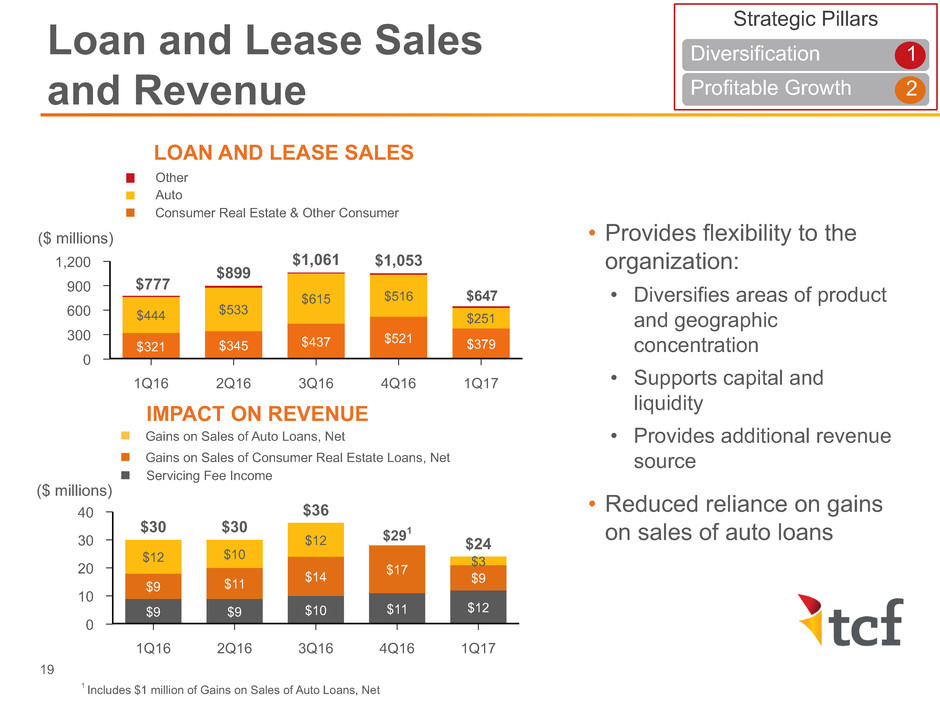
Other Auto Consumer Real Estate & Other Consumer 1,200 900 600 300 0 1Q16 2Q16 3Q16 4Q16 1Q17 $321 $345 $437 $521 $379 $444 $533 $615 $516 $251 $899 $1,061 $1,053 $647 ($ millions) • Provides flexibility to the organization: • Diversifies areas of product and geographic concentration • Supports capital and liquidity • Provides additional revenue source • Reduced reliance on gains on sales of auto loans Loan and Lease Sales and Revenue $64 40 30 20 10 0 1Q16 2Q16 3Q16 4Q16 1Q17 $9 $9 $10 $11 $12 $9 $11 $14 $17 $9 $12 $30 $10 $30 $12 $36 $3 $24 LOAN AND LEASE SALES IMPACT ON REVENUE Servicing Fee Income Gains on Sales of Auto Loans, Net Gains on Sales of Consumer Real Estate Loans, Net Strategic Pillars Diversification 1 Profitable Growth 2 ($ millions) $777 $291 1 Includes $1 million of Gains on Sales of Auto Loans, Net 19

1Q16 2Q16 3Q16 4Q16 1Q17 Consumer Real Estate: First Mortgage Lien 5.40% 5.34% 5.35% 5.22% 5.33% Junior Lien 5.67 5.64 5.60 5.64 5.82 Commercial 4.30 4.30 4.22 4.25 4.43 Leasing & Equipment Finance 4.47 4.45 4.48 4.43 4.48 Inventory Finance 5.68 5.74 6.07 5.80 5.93 Auto Finance 4.14 4.19 4.06 4.04 4.15 Total Loans and Leases 4.89 4.88 4.88 4.82 4.95 Peer Group2 Average 4.36 4.34 4.33 4.34 N.A. COMBINATION OF DIVERSIFICATION AND DISCIPLINED PRICING HAS CREATED CONSISTENT YIELD PERFORMANCE 1 Annualized and presented on a fully tax-equivalent basis 2 All U.S. publicly-traded banks and thrifts, excluding TCF, with total assets between $10 and $50 billion as of December 31, 2016 that have reported loan and lease yields for the past four quarters, includes loans held for sale (source: SNL Financial) N.A. Not Available Loan and Lease Yields1 Strategic Pillars Diversification 1 Profitable Growth 2 20
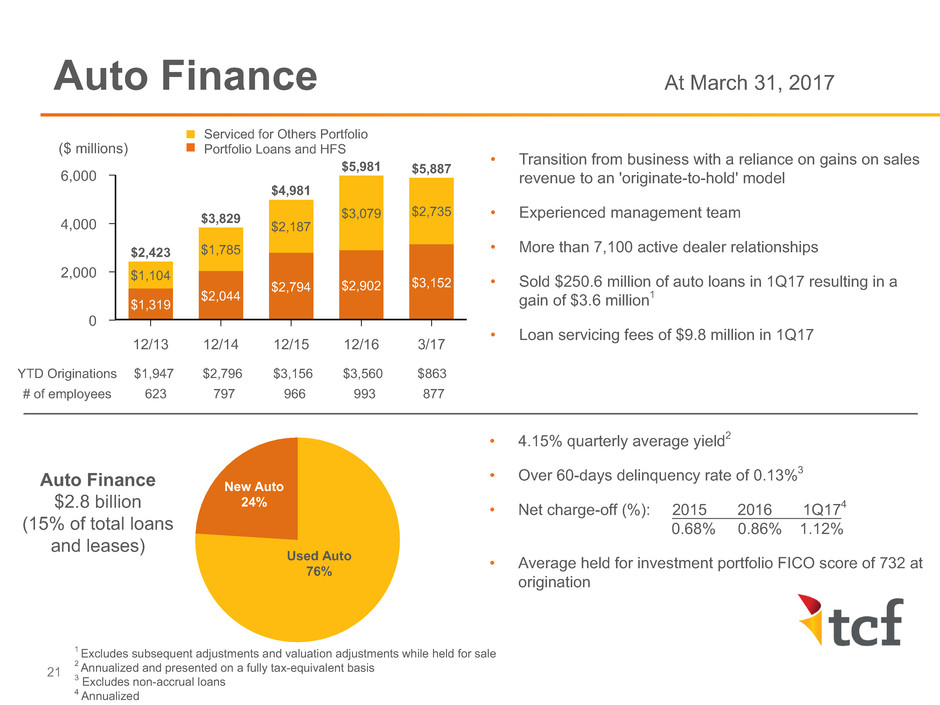
6,000 4,000 2,000 0 12/13 12/14 12/15 12/16 3/17 $1,319 $2,044 $2,794 $2,902 $3,152 $1,104 $2,423 $1,785 $3,829 $2,187 $4,981 $3,079 $5,981 $2,735 $5,887 Auto Finance At March 31, 2017 21 • Transition from business with a reliance on gains on sales revenue to an 'originate-to-hold' model • Experienced management team • More than 7,100 active dealer relationships • Sold $250.6 million of auto loans in 1Q17 resulting in a gain of $3.6 million1 • Loan servicing fees of $9.8 million in 1Q17 Auto Finance $2.8 billion (15% of total loans and leases) • 4.15% quarterly average yield2 • Over 60-days delinquency rate of 0.13%3 • Net charge-off (%): 2015 2016 1Q174 0.68% 0.86% 1.12% • Average held for investment portfolio FICO score of 732 at origination ($ millions) Used Auto 76% New Auto 24% YTD Originations $1,947 $2,796 $3,156 $3,560 $863 # of employees 623 797 966 993 877 Serviced for Others Portfolio Portfolio Loans and HFS 1 Excludes subsequent adjustments and valuation adjustments while held for sale 2 Annualized and presented on a fully tax-equivalent basis 3 Excludes non-accrual loans 4 Annualized
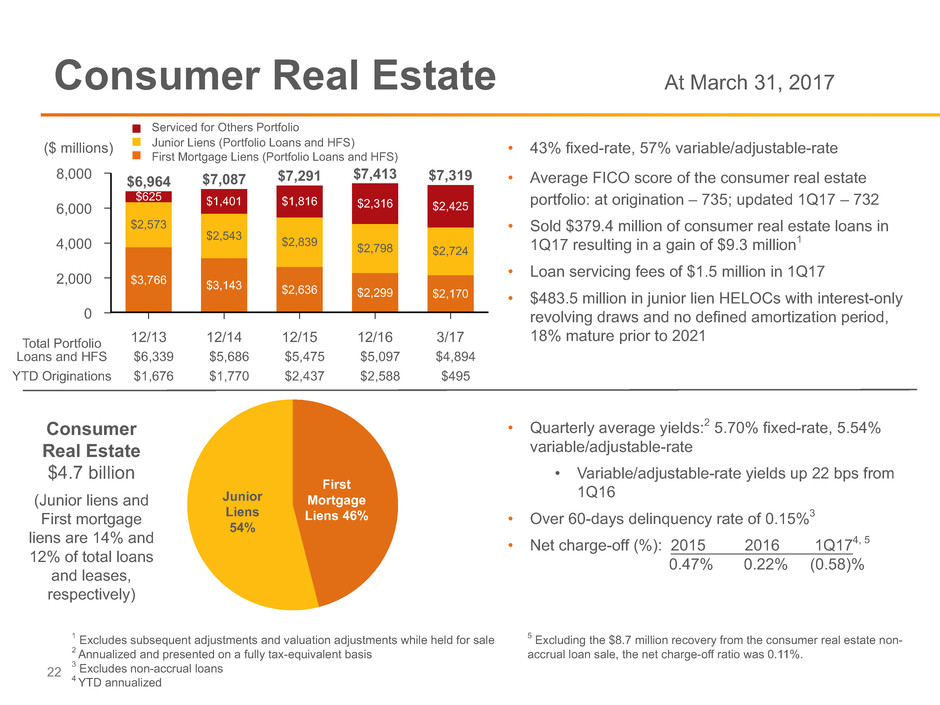
First Mortgage Liens 46% Junior Liens 54% 8,000 6,000 4,000 2,000 0 12/13 12/14 12/15 12/16 3/17 $3,766 $3,143 $2,636 $2,299 $2,170 $2,573 $2,543 $2,839 $2,798 $2,724 $625 $6,964 $1,401 $7,087 $1,816 $7,291 $2,316 $7,413 $2,425 $7,319 22 • 43% fixed-rate, 57% variable/adjustable-rate • Average FICO score of the consumer real estate portfolio: at origination – 735; updated 1Q17 – 732 • Sold $379.4 million of consumer real estate loans in 1Q17 resulting in a gain of $9.3 million1 • Loan servicing fees of $1.5 million in 1Q17 • $483.5 million in junior lien HELOCs with interest-only revolving draws and no defined amortization period, 18% mature prior to 2021 Consumer Real Estate $4.7 billion (Junior liens and First mortgage liens are 14% and 12% of total loans and leases, respectively) ($ millions) Consumer Real Estate At March 31, 2017 Total Portfolio Loans and HFS $6,339 $5,686 $5,475 $5,097 $4,894 YTD Originations $1,676 $1,770 $2,437 $2,588 $495 First Mortgage Liens (Portfolio Loans and HFS) Junior Liens (Portfolio Loans and HFS) Serviced for Others Portfolio • Quarterly average yields:2 5.70% fixed-rate, 5.54% variable/adjustable-rate • Variable/adjustable-rate yields up 22 bps from 1Q16 • Over 60-days delinquency rate of 0.15%3 • Net charge-off (%): 2015 2016 1Q174, 5 0.47% 0.22% (0.58)% 1 Excludes subsequent adjustments and valuation adjustments while held for sale 2 Annualized and presented on a fully tax-equivalent basis 3 Excludes non-accrual loans 4 YTD annualized 5 Excluding the $8.7 million recovery from the consumer real estate non- accrual loan sale, the net charge-off ratio was 0.11%.
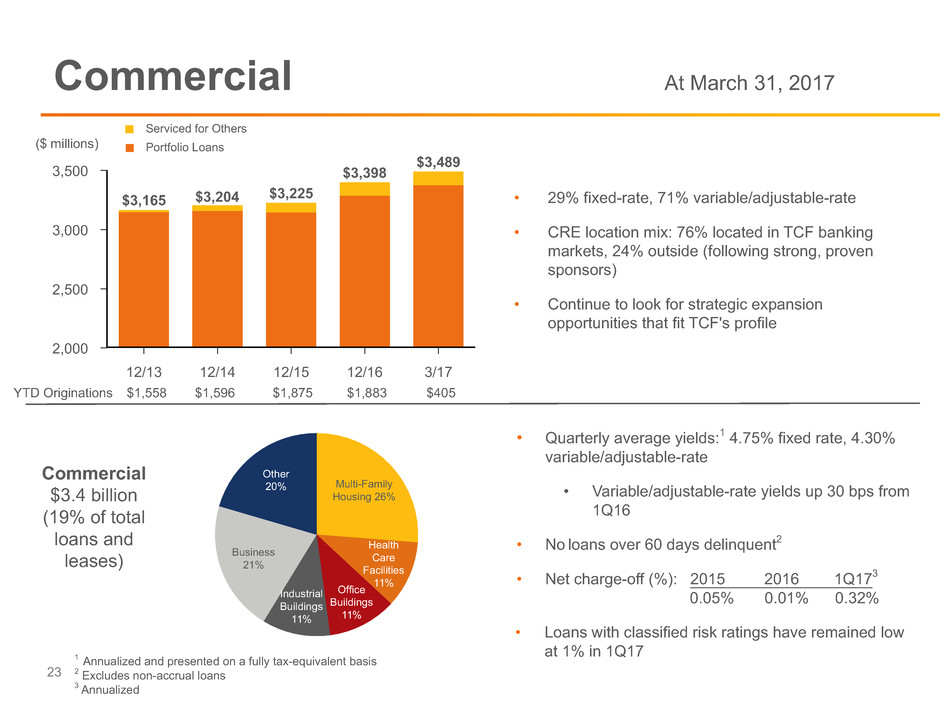
1 Annualized and presented on a fully tax-equivalent basis 2 Excludes non-accrual loans 3 Annualized Multi-Family Housing 26% Health Care Facilities 11%Office Buildings 11% Industrial Buildings 11% Business 21% Other 20% 3,500 3,000 2,500 2,000 12/13 12/14 12/15 12/16 3/17 $3,165 $3,205 $3,225 $3,398 $3,489 23 ($ millions) • 29% fixed-rate, 71% variable/adjustable-rate • CRE location mix: 76% located in TCF banking markets, 24% outside (following strong, proven sponsors) • Continue to look for strategic expansion opportunities that fit TCF's profile • Quarterly average yields:1 4.75% fixed rate, 4.30% variable/adjustable-rate • Variable/adjustable-rate yields up 30 bps from 1Q16 • No loans over 60 days delinquent2 • Net charge-off (%): 2015 2016 1Q173 0.05% 0.01% 0.32% • Loans with classified risk ratings have remained low at 1% in 1Q17 Commercial $3.4 billion (19% of total loans and leases) Commercial At March 31, 2017 YTD Originations $1,558 $1,596 $1,875 $1,883 $405 Portfolio Loans Serviced for Others $3,204
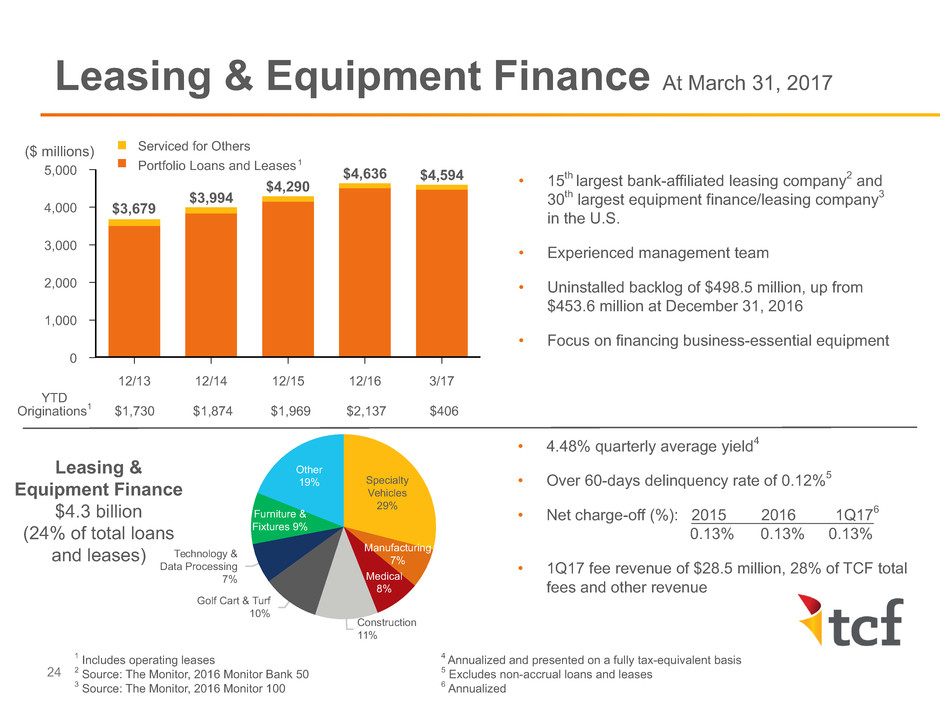
Leasing & Equipment Finance $4.3 billion (24% of total loans and leases) Leasing & Equipment Finance At March 31, 2017 5,000 4,000 3,000 2,000 1,000 0 12/13 12/14 12/15 12/16 3/17 $3,678 $3,994 $4,290 $4,636 $4,594 Specialty Vehicles 29% Manufacturing 7% Medical 8% Construction 11% Golf Cart & Turf 10% Technology & Data Processing 7% Furniture & Fixtures 9% Other 19% Portfolio Loans and Leases ($ millions) 1 Includes operating leases 2 Source: The Monitor, 2016 Monitor Bank 50 3 Source: The Monitor, 2016 Monitor 100 • 15th largest bank-affiliated leasing company2 and 30th largest equipment finance/leasing company3 in the U.S. • Experienced management team • Uninstalled backlog of $498.5 million, up from $453.6 million at December 31, 2016 • Focus on financing business-essential equipment • 4.48% quarterly average yield4 • Over 60-days delinquency rate of 0.12%5 • Net charge-off (%): 2015 2016 1Q176 0.13% 0.13% 0.13% • 1Q17 fee revenue of $28.5 million, 28% of TCF total fees and other revenue 4 Annualized and presented on a fully tax-equivalent basis 5 Excludes non-accrual loans and leases 6 Annualized 24 1 Serviced for Others YTD Originations1 $1,730 $1,874 $1,969 $2,137 $406 $3,679
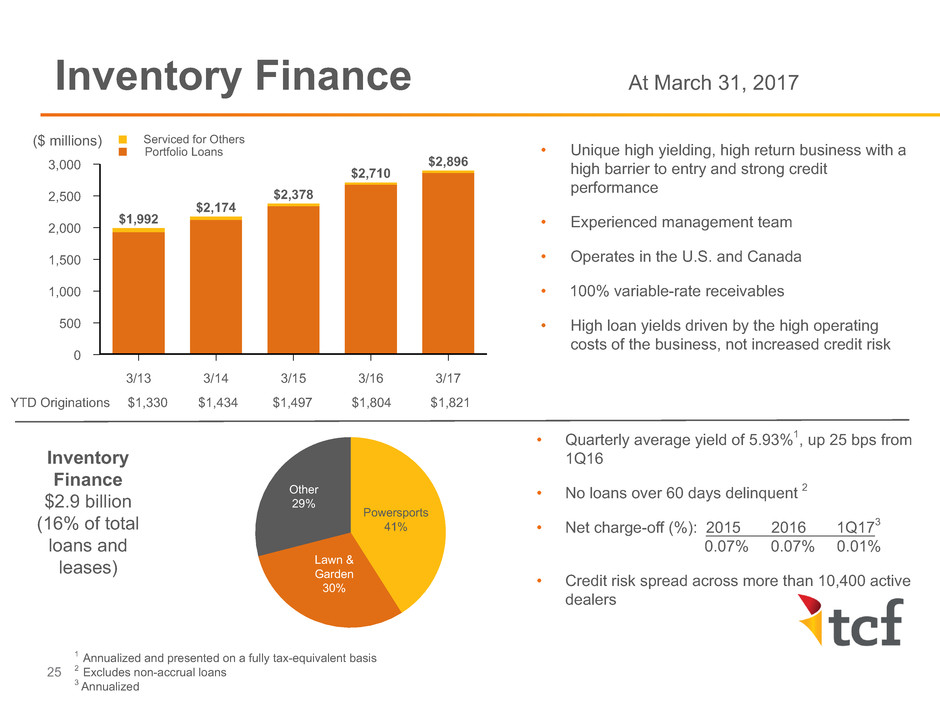
25 ($ millions) 1 Annualized and presented on a fully tax-equivalent basis 2 Excludes non-accrual loans 3 Annualized 3,000 2,500 2,000 1,500 1,000 500 0 3/13 3/14 3/15 3/16 3/17 $1,992 $2,174 $2,378 $2,710 $2,896 Powersports 41% Lawn & Garden 30% Other 29% • Quarterly average yield of 5.93%1, up 25 bps from 1Q16 • No loans over 60 days delinquent 2 • Net charge-off (%): 2015 2016 1Q173 0.07% 0.07% 0.01% • Credit risk spread across more than 10,400 active dealers • Unique high yielding, high return business with a high barrier to entry and strong credit performance • Experienced management team • Operates in the U.S. and Canada • 100% variable-rate receivables • High loan yields driven by the high operating costs of the business, not increased credit risk Inventory Finance $2.9 billion (16% of total loans and leases) YTD Originations $1,330 $1,434 $1,497 $1,804 $1,821 Serviced for Others Portfolio Loans Inventory Finance At March 31, 2017
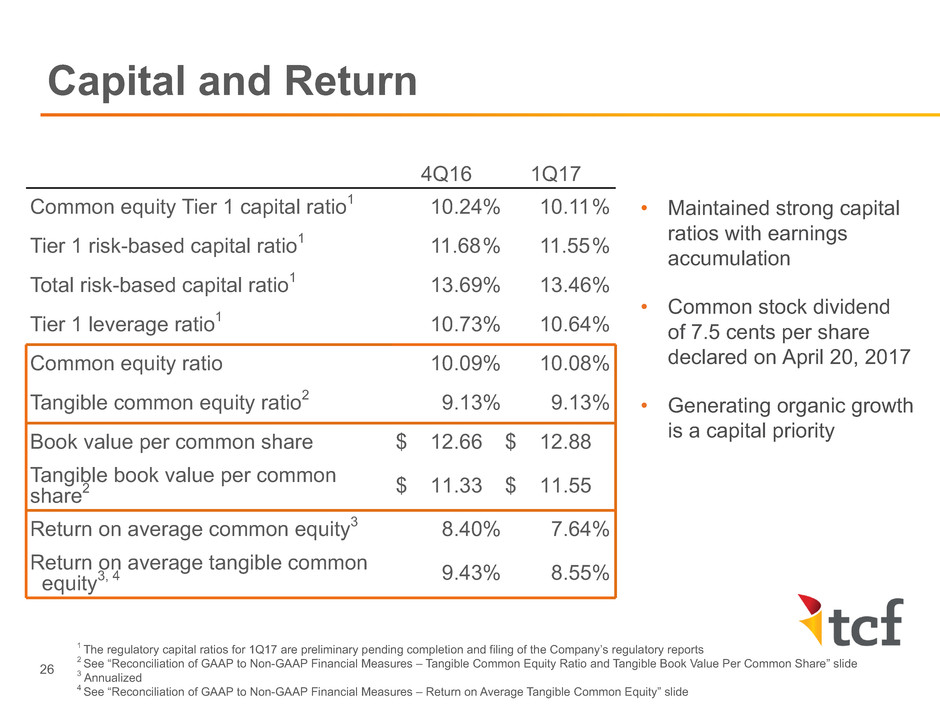
4Q16 1Q17 Common equity Tier 1 capital ratio1 10.24% 10.11% Tier 1 risk-based capital ratio1 11.68% 11.55% Total risk-based capital ratio1 13.69% 13.46% Tier 1 leverage ratio1 10.73% 10.64% Common equity ratio 10.09% 10.08% Tangible common equity ratio2 9.13% 9.13% Book value per common share $ 12.66 $ 12.88 Tangible book value per common share2 $ 11.33 $ 11.55 Return on average common equity3 8.40% 7.64% Return on average tangible common equity3, 4 9.43% 8.55% Capital and Return 1 The regulatory capital ratios for 1Q17 are preliminary pending completion and filing of the Company’s regulatory reports 2 See “Reconciliation of GAAP to Non-GAAP Financial Measures – Tangible Common Equity Ratio and Tangible Book Value Per Common Share” slide 3 Annualized 4 See “Reconciliation of GAAP to Non-GAAP Financial Measures – Return on Average Tangible Common Equity” slide 26 • Maintained strong capital ratios with earnings accumulation • Common stock dividend of 7.5 cents per share declared on April 20, 2017 • Generating organic growth is a capital priority
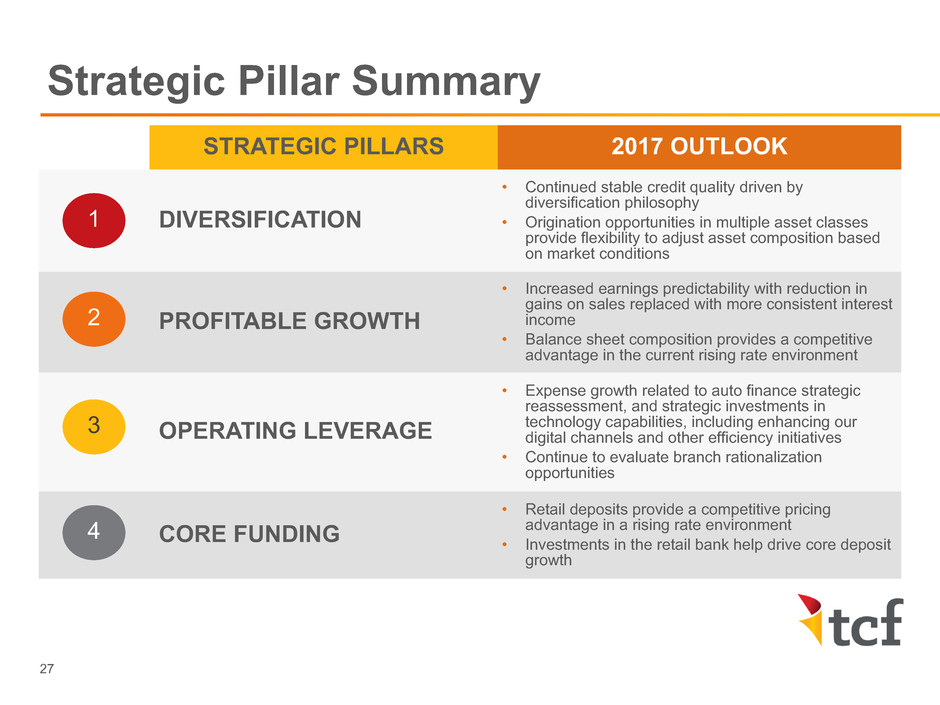
Strategic Pillar Summary STRATEGIC PILLARS 2017 OUTLOOK DIVERSIFICATION • Continued stable credit quality driven by diversification philosophy • Origination opportunities in multiple asset classes provide flexibility to adjust asset composition based on market conditions PROFITABLE GROWTH • Increased earnings predictability with reduction in gains on sales replaced with more consistent interest income • Balance sheet composition provides a competitive advantage in the current rising rate environment OPERATING LEVERAGE • Expense growth related to auto finance strategic reassessment, and strategic investments in technology capabilities, including enhancing our digital channels and other efficiency initiatives • Continue to evaluate branch rationalization opportunities CORE FUNDING • Retail deposits provide a competitive pricing advantage in a rising rate environment • Investments in the retail bank help drive core deposit growth 1 2 3 4 27
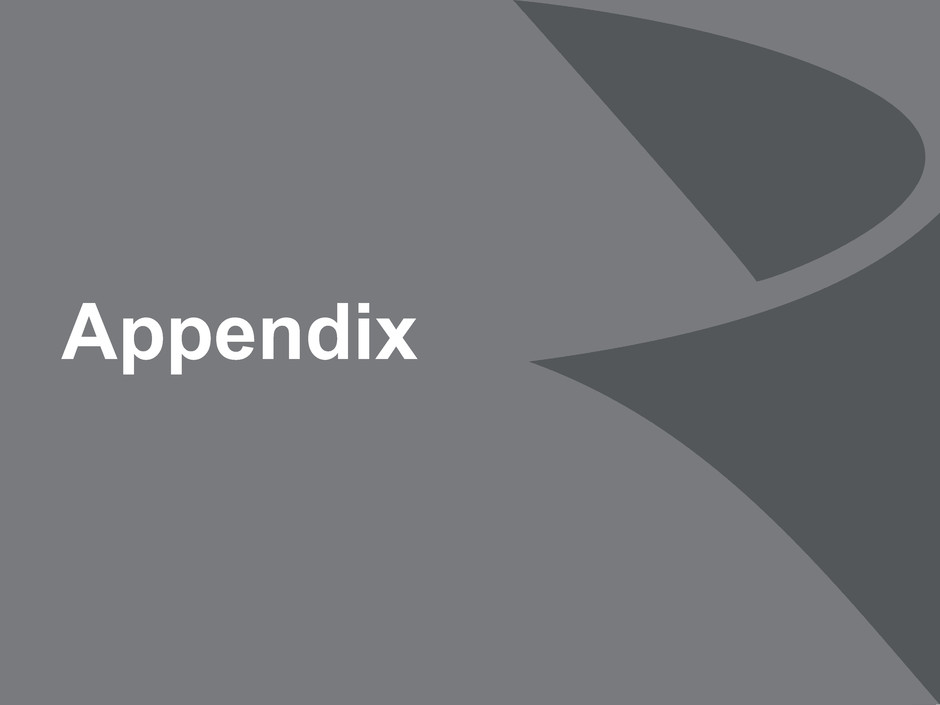
Appendix
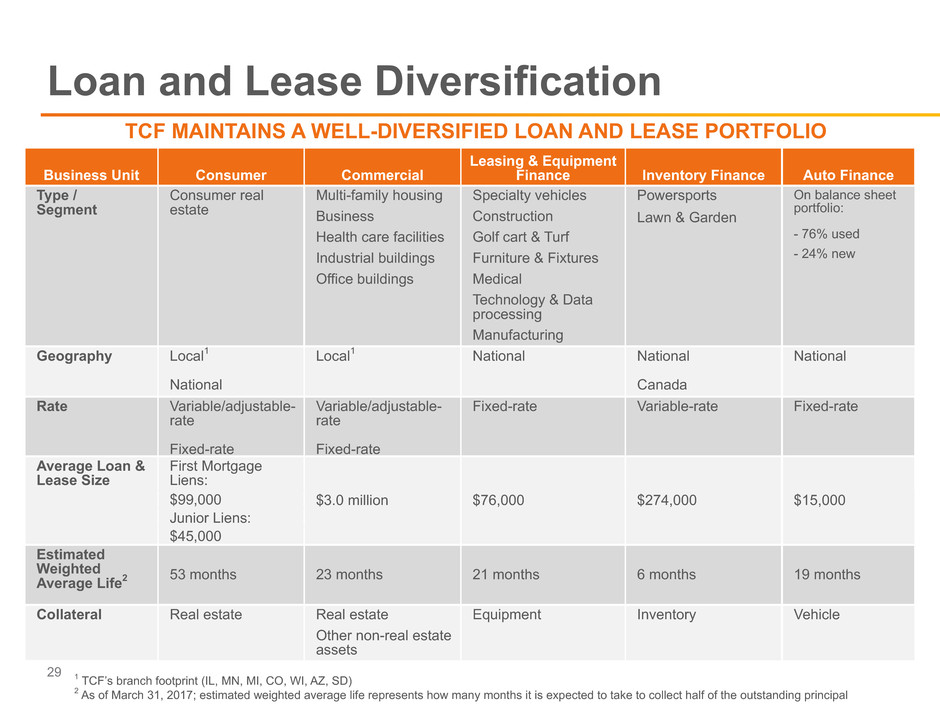
TCF MAINTAINS A WELL-DIVERSIFIED LOAN AND LEASE PORTFOLIO Business Unit Consumer Commercial Leasing & Equipment Finance Inventory Finance Auto Finance Type / Segment Consumer real estate Multi-family housing Business Health care facilities Industrial buildings Office buildings Specialty vehicles Construction Golf cart & Turf Furniture & Fixtures Medical Technology & Data processing Manufacturing Powersports Lawn & Garden On balance sheet portfolio: - 76% used - 24% new Geography Local1 National Local1 National National Canada National Rate Variable/adjustable- rate Fixed-rate Variable/adjustable- rate Fixed-rate Fixed-rate Variable-rate Fixed-rate Average Loan & Lease Size First Mortgage Liens: $3.0 million $76,000 $274,000 $15,000$99,000 Junior Liens: $45,000 Estimated Weighted Average Life2 53 months 23 months 21 months 6 months 19 months Collateral Real estate Real estate Other non-real estate assets Equipment Inventory Vehicle Loan and Lease Diversification 29 1 TCF’s branch footprint (IL, MN, MI, CO, WI, AZ, SD) 2 As of March 31, 2017; estimated weighted average life represents how many months it is expected to take to collect half of the outstanding principal
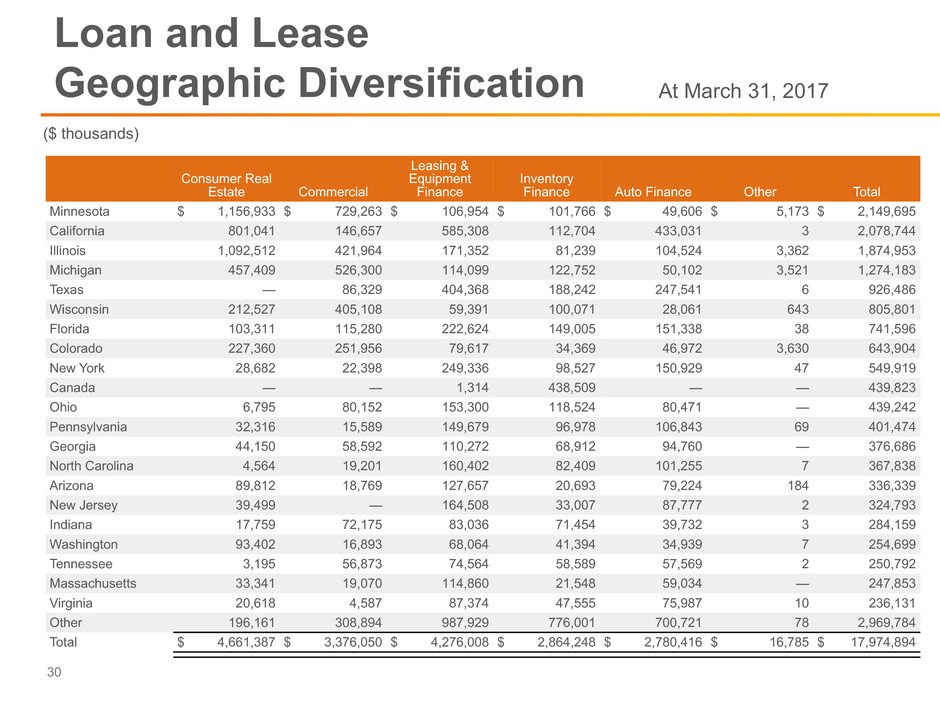
Loan and Lease Geographic Diversification At March 31, 2017 ($ thousands) Consumer Real Estate Commercial Leasing & Equipment Finance Inventory Finance Auto Finance Other Total Minnesota $ 1,156,933 $ 729,263 $ 106,954 $ 101,766 $ 49,606 $ 5,173 $ 2,149,695 California 801,041 146,657 585,308 112,704 433,031 3 2,078,744 Illinois 1,092,512 421,964 171,352 81,239 104,524 3,362 1,874,953 Michigan 457,409 526,300 114,099 122,752 50,102 3,521 1,274,183 Texas — 86,329 404,368 188,242 247,541 6 926,486 Wisconsin 212,527 405,108 59,391 100,071 28,061 643 805,801 Florida 103,311 115,280 222,624 149,005 151,338 38 741,596 Colorado 227,360 251,956 79,617 34,369 46,972 3,630 643,904 New York 28,682 22,398 249,336 98,527 150,929 47 549,919 Canada — — 1,314 438,509 — — 439,823 Ohio 6,795 80,152 153,300 118,524 80,471 — 439,242 Pennsylvania 32,316 15,589 149,679 96,978 106,843 69 401,474 Georgia 44,150 58,592 110,272 68,912 94,760 — 376,686 North Carolina 4,564 19,201 160,402 82,409 101,255 7 367,838 Arizona 89,812 18,769 127,657 20,693 79,224 184 336,339 New Jersey 39,499 — 164,508 33,007 87,777 2 324,793 Indiana 17,759 72,175 83,036 71,454 39,732 3 284,159 Washington 93,402 16,893 68,064 41,394 34,939 7 254,699 Tennessee 3,195 56,873 74,564 58,589 57,569 2 250,792 Massachusetts 33,341 19,070 114,860 21,548 59,034 — 247,853 Virginia 20,618 4,587 87,374 47,555 75,987 10 236,131 Other 196,161 308,894 987,929 776,001 700,721 78 2,969,784 Total $ 4,661,387 $ 3,376,050 $ 4,276,008 $ 2,864,248 $ 2,780,416 $ 16,785 $ 17,974,894 30
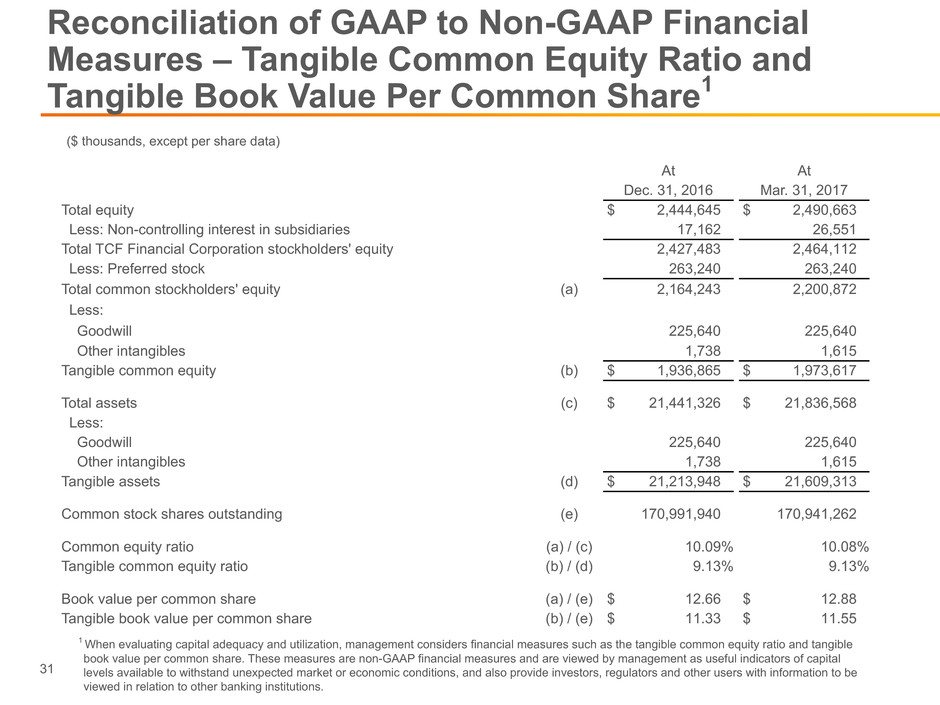
Reconciliation of GAAP to Non-GAAP Financial Measures – Tangible Common Equity Ratio and Tangible Book Value Per Common Share1 At At Dec. 31, 2016 Mar. 31, 2017 Total equity $ 2,444,645 $ 2,490,663 Less: Non-controlling interest in subsidiaries 17,162 26,551 Total TCF Financial Corporation stockholders' equity 2,427,483 2,464,112 Less: Preferred stock 263,240 263,240 Total common stockholders' equity (a) 2,164,243 2,200,872 Less: Goodwill 225,640 225,640 Other intangibles 1,738 1,615 Tangible common equity (b) $ 1,936,865 $ 1,973,617 Total assets (c) $ 21,441,326 $ 21,836,568 Less: Goodwill 225,640 225,640 Other intangibles 1,738 1,615 Tangible assets (d) $ 21,213,948 $ 21,609,313 Common stock shares outstanding (e) 170,991,940 170,941,262 Common equity ratio (a) / (c) 10.09% 10.08% Tangible common equity ratio (b) / (d) 9.13% 9.13% Book value per common share (a) / (e) $ 12.66 $ 12.88 Tangible book value per common share (b) / (e) $ 11.33 $ 11.55 1 When evaluating capital adequacy and utilization, management considers financial measures such as the tangible common equity ratio and tangible book value per common share. These measures are non-GAAP financial measures and are viewed by management as useful indicators of capital levels available to withstand unexpected market or economic conditions, and also provide investors, regulators and other users with information to be viewed in relation to other banking institutions. ($ thousands, except per share data) 31
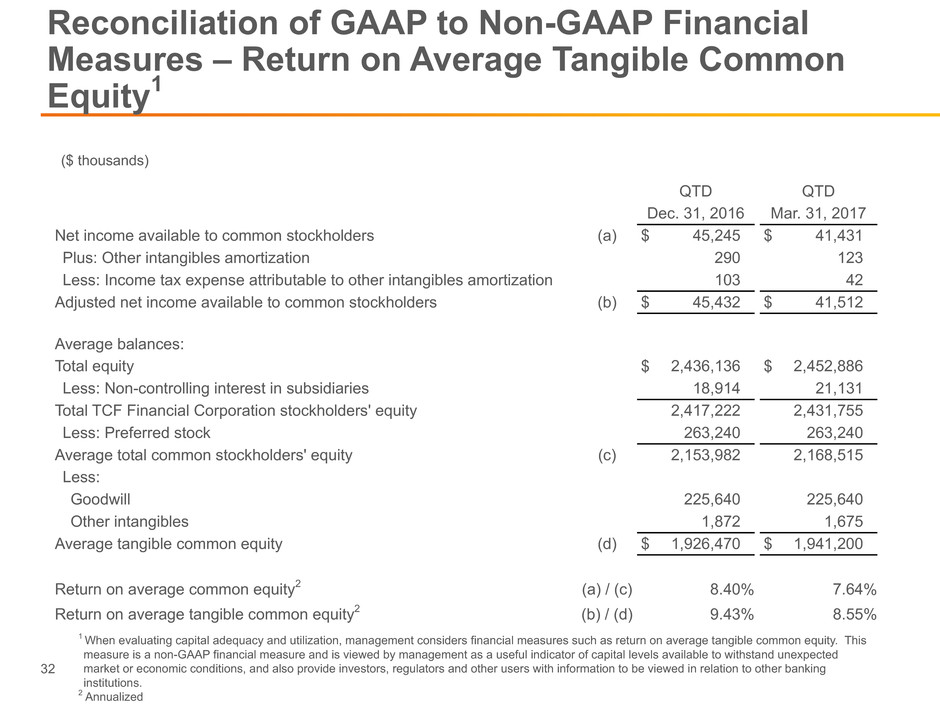
Reconciliation of GAAP to Non-GAAP Financial Measures – Return on Average Tangible Common Equity1 QTD QTD Dec. 31, 2016 Mar. 31, 2017 Net income available to common stockholders (a) $ 45,245 $ 41,431 Plus: Other intangibles amortization 290 123 Less: Income tax expense attributable to other intangibles amortization 103 42 Adjusted net income available to common stockholders (b) $ 45,432 $ 41,512 Average balances: Total equity $ 2,436,136 $ 2,452,886 Less: Non-controlling interest in subsidiaries 18,914 21,131 Total TCF Financial Corporation stockholders' equity 2,417,222 2,431,755 Less: Preferred stock 263,240 263,240 Average total common stockholders' equity (c) 2,153,982 2,168,515 Less: Goodwill 225,640 225,640 Other intangibles 1,872 1,675 Average tangible common equity (d) $ 1,926,470 $ 1,941,200 Return on average common equity2 (a) / (c) 8.40% 7.64% Return on average tangible common equity2 (b) / (d) 9.43% 8.55% ($ thousands) 1 When evaluating capital adequacy and utilization, management considers financial measures such as return on average tangible common equity. This measure is a non-GAAP financial measure and is viewed by management as a useful indicator of capital levels available to withstand unexpected market or economic conditions, and also provide investors, regulators and other users with information to be viewed in relation to other banking institutions. 2 Annualized 32































